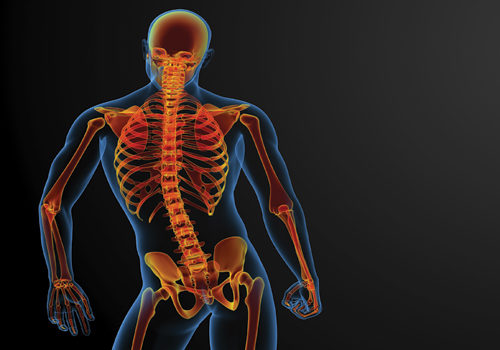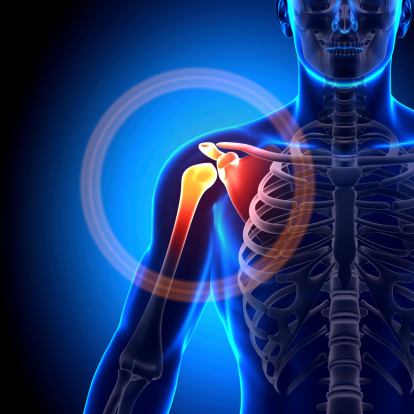Bone health is not only the concern of women and those advanced in years. People of all ages should be aware of the need to build strong bones and should be educated about preventing problems down the road. Over 200 million people worldwide are affected by osteoporosis, according to market research cited by Tracy Kreider, N.D., senior national product educator for Country Life, Hauppauge, NY. The world’s aging population will create a further need for supplements, as well as fortified beverages and foods, to bridge the bone health nutrition gap (1).
Bone Health Vogue
Calcium has long been at the forefront of an attempt to supplement the diet with bone-health nutrients, but the tide may be changing. Calcium supplementation is decreasing, says Julie Dennis, national science educator for Source Naturals/Planetary Herbals, Scotts Valley, CA. This is due to some new research that suggests high calcium intake may be associated with negative effects on the cardiovascular system and other aspects of one’s health. “Emerging research suggests that 500 mg may be the optimal amount of calcium supplementation,” Dennis says.
The controversy over calcium safety has made supplements a target, says Neil E. Levin, CCN, DANLA, nutrition education manager for NOW Foods, Bloomingdale, IL. “Interestingly, a recent study billed as the most rigorous to date in terms of size and control of relevant variables has cleared calcium supplements of their supposed role in heart disease risk,” Levin says. Researchers analyzed data collected from more than 74,000 women participating in the Nurses’ Health Study. The study authors noted that calcium supplement intake was not linked with increased risk of cardiovascular disease. In fact, calcium supplement use was associated with lower coronary heart disease risk.
The authors also touted several strengths of their study over other similar reports, including the large number of cardiovascular events confirmed by medical record review, large sample size, long-term follow-up, detailed and repeated assessment of calcium supplement use that allowed for the examination of a dose–response relationship and assessment and inclusion of other disease risk factors (2).
“No consensus has emerged in the scientific literature on this point, but enough of the debate has become public to confuse many shoppers regarding the health risks and benefits of taking bone health products,” says Dallas Clouatre, Ph.D., consultant for R&D to Jarrow Formulas, Inc., Los Angeles, CA. He feels the industry and retailers in particular must emphasize that full-spectrum nutrient support for bone health, including other nutrients besides calcium, is both safe and effective.
Besides the calcium controversy, Clouatre says the most significant change in direction for bone health recently involves the role of protein. Conventional wisdom once held that protein, especially animal derived, can damage bones by co-opting calcium to neutralize the acid from protein digestion, thus robbing bones of their most vital nutrient. Today, he says, it is recognized that adolescents and elderly people, as distinct groups, seem to consume less protein than is optimal. Further, in the elderly, intake of animal (but not plant) protein is now linked with better bone mineral density (BMD). One recent study found that dairy protein sources like whey and yogurt improve bone health, as they include other bone-supporting nutrients besides protein (3).
However, Clouatre says it remains accepted that a high-protein/low-alkaline mineral diet can negatively impact bone health. “Higher protein intake needs to be matched by an intake of alkaline minerals, such as calcium, magnesium and potassium from green vegetables,” he says.
Levin points out another trend relating to supplements. In this category, vegetarians and vegans often find their choices limited, as raw material and capsule options are often animal-based. This includes ingredients like vitamin D3 and chondroitin sulfate. But despite these obstacles, Levin says the vegan/vegetarian market within the bone health category is growing, as manufacturers take advantage of new materials that are friendly to these diets.
Delivery and compliance. Several factors can 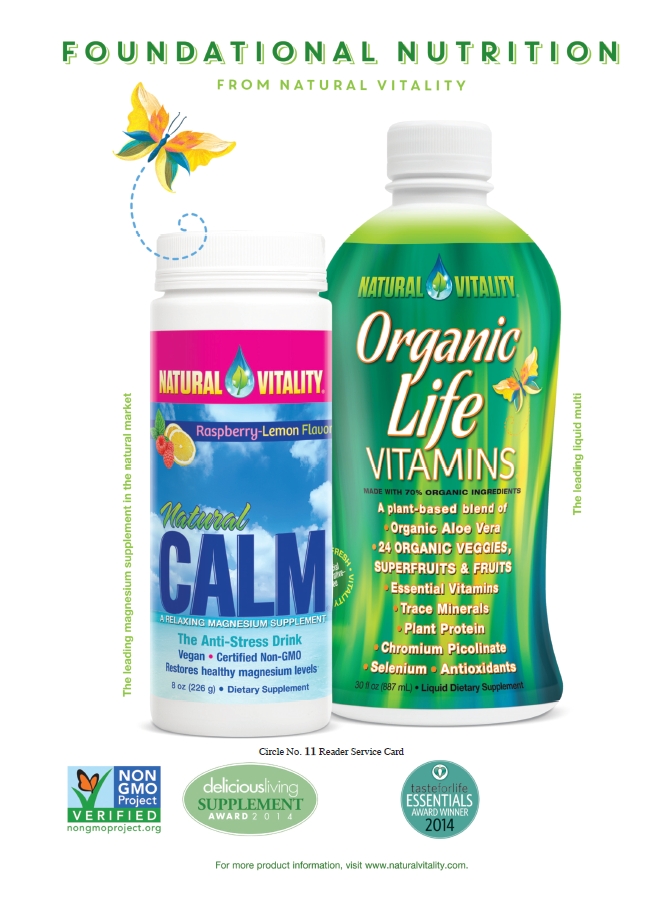 hurt consumers’ compliance with bone health supplement regimens. Fortunately, manufacturer innovation and education can combine to both provide more appealing products and convince consumers how vital it is to give bone health a chance.
hurt consumers’ compliance with bone health supplement regimens. Fortunately, manufacturer innovation and education can combine to both provide more appealing products and convince consumers how vital it is to give bone health a chance.
Dan Chapman, founder and CEO of Redd Remedies, Bradley, IL, says compliance and consistency of use are not just a bone health issue. “We believe that it is the responsibility of the supplement manufacturer to not only create a therapeutic formula, but also one that is as easy to use as possible,” he says.
One problem facing bone health supplement users is tablet and capsule overload. Kreider notes that the average product requires a minimum of two (and often up to six) tablets or capsules a day. One-a-day bone supplements are hard to come by, and such a product would likely be enormous and tough to swallow, she says. Calcium, for one, is large in its molecular structure, Kreider explains.
A large percentage of people have problems swallowing large pills, says Ashley Watson, media content developer at FoodScience of Vermont, Essex Junction, VT. “If consumers have to take too many pills at once to get the recommended serving size, they may give up before they see results, or not try the product at all,” she says.
Dennis says that certain specialized ingredients, like MBP from Megmilk Snow Brand Co., can deliver benefits in smaller pills. She says her company’s product using the ingredient calls for one small capsule per day.
Six to eight capsules per day are commonly used, Clouatre says, in order to deliver clinically tested amounts of calcium, magnesium and the like. “Companies try to finesse this by offering formulas pre-dissolved in liquids, and also dry powders that can be dissolved in liquids prior to ingestion,” he says.
Liquids are very appealing to seniors, according to Trisha Sugarek MacDonald, B.S., M.S., director of R&D and national educator for Bluebonnet Nutrition Corp., Sugar Land, TX. They often take several oral medications, making a liquid bone health supplement preferable to “another pill,” she says. Her company, she adds, caters to the many seniors taking calcium products with a calcium, magnesium and vitamin D3 combination in liquid form.
Liquid supplements make sense in that they save the body the unnecessary effort to dissolve powders into an absorbable form, says Chris D. Meletis, N.D., director of science and research for Trace Minerals Research, Ogden, UT. Along these lines, he believes we should consider that “with so many patients taking antacids, proton pump inhibitors and other such prescription items, calcium and mineral absorption is even more crucial.”
Watson says liquid emulsions help those with absorption issues, or those who need larger amounts of certain nutrients. Liposomal delivery systems, an advanced technology in which ingredients are encapsulated within lipid membranes, aid digestion. Liposomes can also have hydrophilic and hydrophobic properties, Watson says, allowing for both fat-soluble and water-soluble vitamins and minerals to be included. “Flavorings can also make liquid emulsion products more enjoyable to take and more desirable to consumers,” she says.
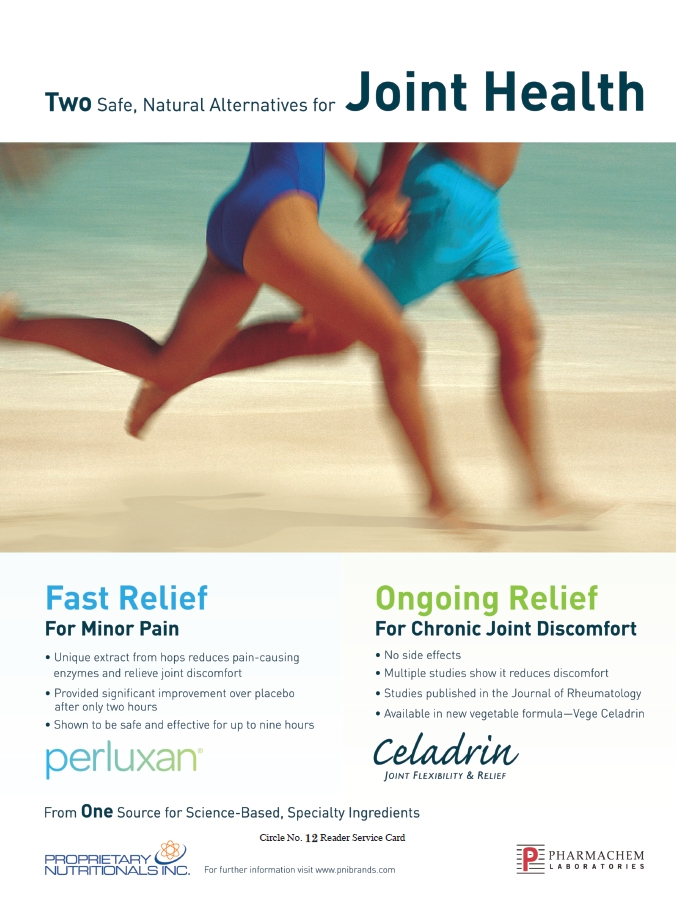 The various forms of calcium are also important for older consumers, Levin says. As people age, stomach acid tends to diminish, making the digestion of calcium from food and non-chelated supplements more difficult. Pre-digested forms of calcium, Levin explains, include calcium citrate, malate and ascorbate, as well as forms bonded to specific amino acids. These weak, low molecular weight acids form a stable bond with the alkaline calcium, he says, resulting in compounds that simulate what is formed naturally during digestion.
The various forms of calcium are also important for older consumers, Levin says. As people age, stomach acid tends to diminish, making the digestion of calcium from food and non-chelated supplements more difficult. Pre-digested forms of calcium, Levin explains, include calcium citrate, malate and ascorbate, as well as forms bonded to specific amino acids. These weak, low molecular weight acids form a stable bond with the alkaline calcium, he says, resulting in compounds that simulate what is formed naturally during digestion.
Calcium capsules may provide an advantage over tablets, since capsules tend to dissolve better, says Gene Bruno, M.S., MHS, director of category management for Twinlab Corporation, New York, NY. “Another approach is to use chewable calcium wafers, thereby entirely eliminating the potential for poor tablet breakdown,” Bruno says.
Options like these continue to emerge. “We’re seeing more and more chewables and gummies in the bone health category. Mini-tab products are also available,” says Dennis. Gummies are perhaps the biggest trend in supplement delivery, in general, says Sugarek MacDonald, but for bone health, this format is tricky because gummies would need to be extremely large. She also says the amount of sugar that would be needed to mask calcium and magnesium might not appeal to health food consumers. Chews, meanwhile, are more viable, and many manufacturers now offer them for bone health, according to Sugarek MacDonald.
Soft gels are also an important bone health delivery option. Luke Huber, N.D., M.B.A., vice president of product innovation and scientific development for Life Extension, Fort Lauderdale, FL, says his company conducted a study using a vitamin D supplement in an oil-based soft gel format. Subjects previously taking a dry 5,000 IU vitamin D formulation in a capsule saw better results after switching. “In 60 days, subjects taking the superior absorption oil-based vitamin D experienced a significant 29% increase in vitamin D levels, despite the fact that there was no change in dose—just delivery format,” says Huber.
Beyond better formats and fewer capsules, consumers may need some encouragement in this category. “One of the hardest things about a product that doesn’t provide some sort of sensation or reaction that can be measured in a quantitative way is a commitment to take it,” says Kreider. Though many consumers may wonder how long it will take for a bone supplement to work, Kreider wonders whether they ask the same question when it comes to making healthy food choices over the long term. The answer, of course, is that those who eat healthy know it’s a full-time job, and the benefits can go unfelt, just like with bone health.
“As I describe to my patients, the bones are like a mountain peak. It takes years to lose significant bone integrity. Likewise, it takes time to see the results from nourishing the osteoblasts,” or bone-creating cells, says Meletis. It is therefore essential, he adds, for people to find products that are easy and enjoyable to take on a daily basis. “Taste,” Meletis says, “does matter.”
Some heavy-duty education on the benefits of supplements may help keep consumers engaged. Convincing evidence for the consistent and continuous use of vitamin K2 supplements (more on K2 later) was produced by a recent study, according to Vladimir Badmaev M.D., Ph.D., head of R&D for NattoPharma ASA, Oslo, Norway. Over three years, 244 postmenopausal women took either 180 mcg daily of the MK-7 form of K2, or a placebo. Badmaev says the results make this a “breakthrough” study, as it was shown for the first time that vitamin K2 provides clinically, statistically significant protection of the vertebrae and the hip against osteoporosis, along with other benefits (4).
These findings contrast with shorter studies on K2, such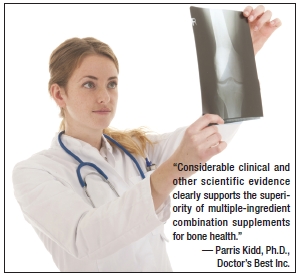 as those that last a year, which have typically failed to show significant benefits for bone health or cardiovascular health. Badmaev says that this case “exemplifies a classic approach to convincing a general population to sustain a beneficial health practice for an extended period of time, if not indefinitely.” He compares the situation to that of 81 mg of baby aspirin being taken every day for life by those with cardiovascular risk. The practice is grounded in research that shows benefits are not obvious over a long period of time and the benefits are not experienced directly by users.
as those that last a year, which have typically failed to show significant benefits for bone health or cardiovascular health. Badmaev says that this case “exemplifies a classic approach to convincing a general population to sustain a beneficial health practice for an extended period of time, if not indefinitely.” He compares the situation to that of 81 mg of baby aspirin being taken every day for life by those with cardiovascular risk. The practice is grounded in research that shows benefits are not obvious over a long period of time and the benefits are not experienced directly by users.
Education is an essential piece of successful marketing in this category, Watson says. She explains that her company’s marketing department works with R&D to keep on top of research and trends, and that it reaches out to consumers through multiple outlets: sell sheets, blogging, e-mail campaigns, social media, distributor training, regular sales trainings and tradeshows. Cheryl Myers, chief of education and scientific affairs at EuroPharma, Inc., Green Bay, WI, says that providing education to retail partners in the form of product webinars, ingredient information and in-store presentations is a point of pride.
“Education is key for individuals to understand the importance and variety of factors that impact bone health, as well as the devastating effects of hip fracture when bones weaken,” says Huber. Parris Kidd, Ph.D., chief science officer for Doctor’s Best Inc., San Clemente, CA, says of engaging in consumer education, “I consistently find that many consumers are eager to learn more about how bone is formed, renewed and maintained.” For some, it is a revelation that bone is a living tissue, and that calcium is just one nutrient of many that are essential.
Finding the Right Mix
There is a growing awareness of the bone-support market, and consumers are educating themselves. “I think most have realized that the chewing TUMS every day is not going to be adequate to build and maintain bones,” Kreider says. But there is a lot of information out there, and many options to comb through.
In addition, science indicates that certain nutrients in combination are required for strong bones that can withstand the stresses of life. “There is considerable clinical and other scientific evidence that clearly supports the superiority of multiple-ingredient combination supplements for bone health,” Kidd says. What are these essential elements? What would go into the ideal bone health cocktail, if you will?
Some ingredients that come highly recommended are relative newcomers in bone health circles, foremost among these probably being vitamin K. “Vitamin K has been emerging in most bone formulas now, where in the past it was not included,” says Kreider.
According to Badmaev, research has focused on the two natural types of vitamin K: phylloquinones (vitamin K1) and menaquinones (vitamin K2). “Structural differences between vitamin K1 and vitamin K2 are known to affect the way these vitamins are transported, taken up by target tissues, stored and subsequently excreted,” he says.
Bruno tells us that specific forms of vitamin K2 are designated according to the number of repeating 5-carbon units in the side chain of the molecule. “For example, if there are seven repeating 5-carbon units, the designation will be menaquinone-7 or MK-7,” he says. The MK-7 form, Levin says, has been shown to be more bio-available than other forms like MK-4.
Both K1 and K2 activate proteins crucial for bone health in a process called carboxylation, Badmaev explains. K2, in particular, is responsible for the activation of osteocalcin, a protein that plays a vital part in the bone-building process. K2 also activates matrix GLA protein (MGP), which helps prevent the calcification of blood vessels. Thus, K2 performs the dual function of helping build calcium deposits in healthy bone via osteocalcin, and helping prevent calcium deposits in the circulatory system via MGP. Bruno notes that MGP is also found in bones, and is thought to help facilitate normal bone growth.
Part of the mechanism of MK-7, Badmaev adds, may be in preventing excessive inflammation, which helps limit the proliferation of osteoclasts (which break down bone). “While practically 100% of a general, healthy population is sufficient in vitamin K for supporting blood coagulation factors, up to 98% of the same general population is insufficient in vitamin K2 for functions supporting healthy bones, the cardiovascular system and the metabolic system,” Badmaev says.
Huber suggests supplementation with a blend of vitamin K forms (K1, and K2 as MK-4 and MK-7) in a soft gel for optimal absorption.
With advances in the understanding of nutrients like vitamin K and others, we may be moving closer to that ideal bone health formula. Myers agrees, and says a blend of calcium, magnesium, vitamin D3, vitamins K1 and K2 (she suggests MK-7 from natto), copper and other nutrients is a good starting place. She says her company includes these nutrients along with a host of other easily absorbed minerals in a combination bone product.
Other suggestions for the ideal formula fall along the same lines, with certain inclusions and omissions. Chapman adds the mineral boron to Myers’ list. “In the natural products industry, we believe there is consensus that these are the basic nutrients vital to strong, healthy bones,” he says. While in the conventional market, Chapman adds, there may be some disagreement on the importance of vitamin K2, there is substantial scientific evidence of its importance.
Potassium and trace minerals, as well as B-complex vitamins and vitamin C, are also valuable for bone health, says Sugarek MacDonald.
Clouatre adds several more minerals to the mix, including manganese, silicon and zinc, while Meletis recommends strontium.
Watson, meanwhile, refers us to the benefits of a specific trio. “While the combination of vitamin A, vitamin D3 and vitamin K2 is not commonly used in a bone integrity support product, new research indicates that combining these specific vitamins can provide unique benefits,” she says. In the book Vitamin K2 and the Calcium Paradox, Watson says Kate Rheaume-Bleue, N.D., argues that these three vitamins are interrelated when it comes to bone health.
The bone-building benefits of vitamin D rely on K2. Vitamin A assists vitamin D in boosting the production of osteocalcin, which is then activated by K2. Rheaume-Bleue contends that these three fat-soluble vitamins are special because they bind to proteins, particularly vitamin K. This allows the proteins to bind to calcium so it can be better utilized by the body. Taking a standalone A, D and K product isn’t necessary, Watson says, as a comprehensive multivitamin with sufficient amounts of each should do the trick.
Our knowledge of each of these major bone health nutrients can and has filled many books. Here we’ll offer a few glimpses. Firstly, Bruno explains that calcium is a major structural element in bones and teeth, along with phosphate. These two together form hydroxyapatite crystals, a major constituent of bone. “There are multiple forms of calcium from which to choose, with research showing that calcium citrate is absorbed better than other forms of calcium tested,” Bruno says, before adding that all forms of calcium are likely beneficial.
Myers observes that the amount of calcium needed can be lowered when combined with other nutrients that enhance its absorption. Too much calcium can suppress vitamin D in the bloodstream. “Vitamin D is crucial in maintaining healthy bones (and cellular health overall), so by overdoing it with too much calcium, you may actually undermine the natural process of bone building in the body,” Myers says.
For years, she explains, recommended levels of vitamin D intake were set too low. “We’re just beginning to see conventional medical practice catch up with the idea that many people—perhaps most of us, especially in northern climates with long winters—are deficient in vitamin D,” Myers says.
“The research on vitamin D is rich and ever-expanding; everyone should be optimizing their vitamin D levels,” adds Huber. He believes individuals should have their blood tested for 25-hydroxyvitamin D to know where they stand.
Magnesium, meanwhile, is another crucial calcium partner. “Bone has a very substantial content of magnesium and it functions in a ‘yin-yang’ balancing act with calcium. There is no magic ‘ratio’ of calcium to magnesium supplementation, but surveys find a majority of Americans are deficient in magnesium,” says Kidd. He also emphasizes that vitamin C, though often overlooked for bone health, is an essential cofactor for an enzyme that cross-links collagen, which is needed to make the bone matrix sturdy.
Zinc is also a cofactor for enzymes found in bone tissue, according to Dennis. Boron, she says, supports the metabolism of calcium, manganese aids the formation of connective tissue and copper supports the production of collagen.
“Strontium supports the formation of bone and decreases the breakdown of bone. It’s a critical—and often ignored—component for enhancing bone mineral density (BMD),” says Myers.
|
Bone Health Products
American Health: Ester-C 1000 mg with D3 5000 IU Bone & Immune Health Complex. Bluebonnet Nutrition Corp.: Liquid Calcium Magnesium Citrate, Osteo-Bone Formula Vcaps, Super Boron Bone Formula Vcaps, Calcium Citrate Magnesium Plus Vitamin D3 Caplets, Magnesium Calcium 2:1 Ratio Vcaps, Milk-Free Calcium 1200 mg Softgels, Calcium Magnesium Plus Boron Capsules, Vitamin D3. Country Life: Bone Solid, Total Mins, Total Mins without Iron, Calcium Magnesium Complex, Bone Density Factors. Doctor’s Best: Calcium Bone Maker Complex, Best Multiple, Best Vitamin D3, Best Vegan D3, Natural Vitamin K2 MenaQ7, High-Absorption Magnesium, Best Vitamin C Featuring Quali-C, Pure-Way C Sustained Release Vitamin C, Strontium Bone Maker, Best Collagen Types 1 & 3. EuroPharma, Inc.: OsteoStrong, Vitamin D3, Strontium, Bone-Sil. FoodScience of Vermont: OsteoActiv, DMG, Calcium, Magnesium, Glucosamine, MSM, Multivitamin and mineral supplements. Jarrow Formulas, Inc. : Bone-Up, Ultra Bone-Up, Bone-Up Three Per Day, Bone-Up (Vegetarian), JarroSil Activated Silicon. Life Extension: Bone Restore, Bone Strength Formula with KoAct, Vitamin D product series, Vitamin K product series. NattoPharma: MenaQ7 (Natural Vitamin K2). NOW Foods: Bone Calcium tabs and Bone Strength tabs, Full Spectrum Minerals (caps or tabs), Red Mineral Algae, Cal-Mag DK Caps, MK-7 Vitamin K-2. Redd Remedies: Bone Health, Bone Health Advanced. Source Naturals: MBP Bone Renew, MBP Osteo with Calcium, Vitamin D-3, Ultra-Cal Night with Vitamin K. Trace Minerals Research: Liquid Cal/Mag/Zinc, Liquid Coral Extra, Complete Cal/Mag 1:1, Complete Coral Calcium w/ConcenTrace, Ionic Boron, Ionic Magnesium. Twinlab Corp.: Bone Support with Ostivone, Calcium Citrate Caps, Calcium Citrate Chewable Wafers, Vitamin D 2000 IU Dots, Mega D3 Dots 5000 IU, Vitamin D3 1000 + K2 Dots. |
|
Bone health selections. Several other nutrients, nutrient compounds and specialized ingredients for bone health need your attention as well. Badmaev starts us off with essential fatty acids (especially DHA), which studies indicate play an important role in the regulation of bone metabolism. The ratio of omega-3 to omega-6 fatty acids is of particular importance to bone health, he notes. The mechanisms involved may include an effect on calcium balance, effects on the physiology of bone cells and decreases in inflammatory factors that may negatively influence bone integrity. Such inflammatory factors include interleukins and TNF-alpha. This anti-inflammatory action, Badmaev says, may reveal synergy between fatty acids and vitamin K2.
Carotenoids like lycopene, alpha- and beta-carotene, beta-cryptoxanthin, lutein and zeaxanthin are linked with bone health benefits. Badmaev cites a study that found a relationship between serum carotenoid concentrations, fruit and vegetable intake and osteoporosis in postmenopausal women. Carotenoids linked with bone health were found at lower levels in women with osteoporosis as compared with healthy controls (5).
If levels of testosterone, growth hormones or DHEA are low, bone health can become impaired, Meletis says. He cites a study that lists DHEA as a potential option for helping to prevent fractures in postmenopausal women (6).
The ingredient MBP, discussed earlier in the context of capsule size, is a milk protein complex found in whey that aids the body’s bone renewal process, according to Dennis. In addition to stimulating osteoblasts to build bone, it helps make bones more receptive to dietary calcium, she says.
A calcium ingredient derived from eggshell (ESC from ESM Ingredients) is highly bioavailable, Chapman says. Because it is naturally accompanied by transporter proteins and other nutrients, it is easier for the body to absorb and use. The purity of this ingredient is also notable, he adds, as it has heavy metal levels 50 times lower than Prop 65 limits.
According to Clouatre, the emphasis on bone mineral density (BMD) is shifting. As focus on BMD fades, fracture prevention is taking center stage. Collagen, for example is a major constituent of bone that impact bones’ resistance to fracture. Despite media focus on BMD, Clouatre says, preserving or even increasing BMD does not reduce fracture risk for most women. “Bone is living tissue that must constantly be repaired. It is the quality of the repair, not just the amount, that matters,” he says.
A relevant supplement option to this new way of thinking is bone-derived calcium. Clouatre says ossein-hydroxyapatite complex (OHC), a complex of hydroxyapatite calcium and protein, is isolated from bovine bone. Ossein is rich in collagen, osteocalcin and growth factors for bone health, he says. A study comparing calcium carbonate with OHC found that OHC increased BMD by at least an additional 1%, and vertebrae-specific BMD by 5% more (7).
N,N-Dimethylglycine is a naturally occurring amino acid derivative and methyl donor that supports metabolic processes, according to Watson. She says her company makes special use of this ingredient in its bone and joint products.
High-molecular weight hyaluronic acid (HA) of over 500,000 Daltons in size, according to Levin, has been shown in animal models to reduce bone turnover and help maintain healthy bone mass. He also describes a red mineral algae ingredient (Aquamin from Marigot Ltd.) that is a rich vegetarian source of calcium, magnesium and over 70 other trace minerals. Levin says this seaweed-derived complex may support proper bone mineralization.
Herbs for bone health. “Botanicals hold a lot of promise in aiding bone health,” says Levin. Oat straw and alfalfa are two options known for mineral content, he says, while Dennis describes others. “Stinging nettle and horsetail are two examples of herbs that contain trace amounts of minerals and nutrients known to support bone health,” she says. Horsetail contains silica, and nettle contains calcium, potassium, vitamin K and other nutrients.
Myers says silica is a critical nutrient often left out of the bone health mix. One of her company’s products contains silica from the above-ground parts of the spring horsetail (Equisetum arvense) plant. The silica is extracted as a compound with the plant bioflavonoids that support its activity in the body. Myers explains that organic silica also impacts the formation of collagen, and that it can help balance the ratio at which minerals are added to and withdrawn from bone (anabolism and catabolism).
Phytoestrogens, particularly isoflavones, from legumes and flax also may support healthy bone, Levin says. Results are inconclusive about the use of soy compounds, which contain phytoestrogens, for bone health, according to Sugarek MacDonald. “Although more research is needed, a few herbs like red clover and black cohosh, and natural foods like soy may help reduce bone loss caused by osteoporosis,” she says. These herbs have estrogenic activity, and one of estrogen’s functions is to help maintain bone density.
Ipriflavone, synthesized from a soy isoflavone, has been shown to support osteoblasts, Sugarek MacDonald says, stating, “When taken with calcium, it aids in the incorporation of this important mineral into the porous material of bones, thus supporting optimal bone formation.”
A number of prebiotics fibers derived from plants are linked with reduced bone turnover, according to Clouatre. These include inulin and fructooligosaccharides. WF
References
1. Canadean Ltd. Calcium Fortification In Beverages - Ingredients Trends and Market Insights, April 2014, http://www.researchandmarkets.com/research/xm6zfc/calcium, accessed May 20, 2014.
2. J.M. Paik, et al., “Calcium Supplement Intake and Risk of Cardiovascular Disease in Women,” Osteoporos. Int. (2014) [Epub ahead of print].
3. R. Rizzoli, “Dairy Products, Yogurts, and Bone Health,” Am. J. Clin. Nutr. 99(5), 1256S-62S (2014).
4. M.H. Knapen, et al., “Three-year Low-dose Menaquinone-7 Supplementation Helps Decrease Bone Loss in Healthy Postmenopausal Women,” Osteoporos. Int. 24(9), 2499-507 (2013).
5. Z. Yang, et al., “Serum Carotenoid Concentrations in Postmenopausal Women from the United States with and without Osteoporosis,” Int. J. Vitam. Nutr. Res. 78(3), 105-11 (2008).
6. M.S. Christianson, W. Shen, “Osteoporosis Prevention and Management: Nonpharmacologic and Lifestyle Options,” Clin. Obstet. Gynecol. 56(4), 703-10 (2013).
7. C. Castelo-Branco, et al., “Efficacy of Ossein-hydroxyapatite Complex Compared with Calcium Carbonate to Prevent Bone Loss: A Meta-analysis,” Menopause 16(5), 984-91 (2009).
Published in WholeFoods Magazine, July 2014

